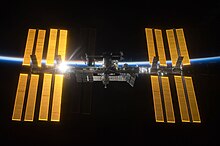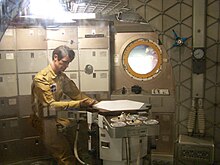List of space stations
Orbitial Sciences Commercial Space by Rishabh Sharma on Scribd
 |
The International Space Station in front of the Earth. This image was taken by space shuttle Discovery while pulling away during STS-119. |
 |
Skylab viewed from the command module of Skylab 2 |
Space stations are used to study the effects of long-term space flight on the human body. They also serve as a platform for extended scientific studies. All space stations have been designed with the intention of rotating multiple crews, with each crew member staying aboard the station for weeks or months, but rarely more than a year. As of 2012, Vladimir Titov, Musa Manarov, and Valeriy Polyakov have completed single missions of over a year, all aboard Mir.
Space stations have been used for both military and civilian purposes. The first military-use space station was Salyut 2, which was launched by the Soviet Almaz program in 1973. The Soviet Union also claimed the first civilian space station with the launch of Salyut 1. As of 2012, Russia, China, and private companies are building space stations.
Past stations
These stations have re-entered the atmosphere and disintegrated.
The Soviet Union ran two programs simultaneously, both of which were known to the outside world as Salyut. The Long Duration Orbital Station (DOS) program was intended for scientific research into spaceflight. The Almaz program was a secret military program that tested space reconnaissance tactics.| Name | Entity | Program | Crew size | Launched | Reentered | Days in orbit | Days occupied | Total crew and visitors | Number of manned visits | Number of unmanned visits | Mass | Pressurized volume |
|---|---|---|---|---|---|---|---|---|---|---|---|---|
| Salyut 1 | DOS | 3 | 19 April 1971 | 11 October 1971 | 175 | 24 | 6 | 2 | 0 | 18,425 kg (40,620 lb) | 100 m3 (3,500 cu ft) | |
| DOS-2 | DOS | — | 29 July 1972 | 29 July 1972 (failed to reach orbit) | — | — | — | — | — | 18,000 kg (40,000 lb) | — | |
| Salyut 2 | Almaz | — | 3 April 1973 | 16 April 1973 | 13 | — | — | — | _ | 18,500 kg (40,800 lb) | — | |
| Kosmos 557 | DOS | — | 11 May 1973 | 22 May 1973 | 11 | — | — | — | — | 19,400 kg (42,800 lb) | — | |
| Skylab | Skylab | 3 | 14 May 1973 | 11 July 1979 | 2249 | 171 | 9 | 3 | 0 | 77,088 kg (169,950 lb) | 360 m3 (12,700 cu ft) | |
| Salyut 3 | Almaz | 2 | 25 May 1974 | 24 January 1975 | 213 | 15 | 2 | 1 | 0 | 18,900 kg (41,700 lb) (at launch) | 90 m3 (3,200 cu ft) | |
| Salyut 4 | DOS | 2 | 26 December 1974 | 3 February 1977 | 770 | 92 | 4 | 2 | 1 | 18,900 kg (41,700 lb) (at launch) | 90 m3 (3,200 cu ft) | |
| Salyut 5 | Almaz | 2 | 22 June 1976 | 8 August 1977 | 412 | 67 | 4 | 3 | 0 | 19,000 kg (42,000 lb) (at launch) | 100 m3 (3,500 cu ft) | |
| Salyut 6 | DOS | 2 | 29 September 1977 | 29 July 1982 | 1764 | 683 | 33 | 16 | 14 | 19,000 kg (42,000 lb) | 90 m3 (3,200 cu ft) | |
| Salyut 7 | DOS | 3 | 19 April 1982 | 7 February 1991 | 3216 | 861 | 22 | 10 | 15 | 19,000 kg (42,000 lb) | 90 m3 (3,200 cu ft) | |
| Mir |
| DOS | 3 | 19 February 1986 | 23 March 2001 | 5511 | 4594 | 125 | 39 | 68 | 129,700 kg (285,900 lb) | 350 m3 (12,400 cu ft) |
Prototypes
These stations are prototypes; they only exist as testing platforms and will never be manned. OPS 0855 was part of a cancelled Manned Orbiting Laboratory project by the United States, while the Genesis stations were launched privately and remain in orbit.| Name | Entity | Program | Launched | Reentered | Days in orbit | Mass | Pressurized volume |
|---|---|---|---|---|---|---|---|
| OPS 0855 | MOL | 3 November 1966 | 9 January 1967 | 67 | 9,680 kg (21,340 lb) | 11.3 m3 (400 cu ft) | |
| Genesis I | Bigelow Aerospace | 12 July 2006 | (In Orbit) | 3724 | 1,360 kg (3,000 lb) | 11.5 m3 (410 cu ft) | |
| Genesis II | Bigelow Aerospace | 28 June 2007 | (In Orbit) | 3373 | 1,360 kg (3,000 lb) | 11.5 m3 (406 cu ft) |
Operational stations
These stations are currently orbiting Earth. They have life support systems in place.
| Name | Entity | Crew size | Launched | Days in orbit | Days occupied | Total crew and visitors | Manned visits | Unmanned visits | Mass | Pressurized volume |
|---|---|---|---|---|---|---|---|---|---|---|
| International Space Station |
| 6 | 20 November 1998 | 6515 | 5804 | 215 | 75 | 72 | 417,289 kg (919,965 lb) | 907 m3 (32,000 cu ft) |
| Tiangong 1 | 3 | 29 September 2011 | 1819 | 25 | 6 | 2 | 1 | 8,506 kg (18,753 lb) | 15 m3 (530 cu ft) | |
| Tiangong 2 | 2 | 15 September 2016 | 6 | 0 | 0 | 0 | 0 | 8,600 kg (19,000 lb) |
Planned stations
These space stations have been announced by their host entity and are currently in active development or production. The launch date listed here may change as more information becomes available.Cancelled projects
 |
An image of the interior of Skylab B, on display at the Smithsonian's National Air and Space Museum |
| Space station | Entity | Crew size | Launch date | Remarks |
|---|---|---|---|---|
| Manned Orbiting Laboratory 1-7 | 2 | Mockup launched 3 November 1966 (In orbit 40 days, cancelled after launch) | Canceled due to excessive costs | |
| Skylab B | 3 | Between 1975 and 1979 (planned) | Canceled due to lack of funding | |
| Galaxy | (private) | Unmanned | late 2008 (planned) | Canceled due to rising costs and ability to ground test key Galaxy subsystems |
| Mir-2 | 2 | 1993 | Canceled due to financial difficulties | |
| Freedom | 14-16 | March 1994 | Converted into the International Space Station |
Timeline



